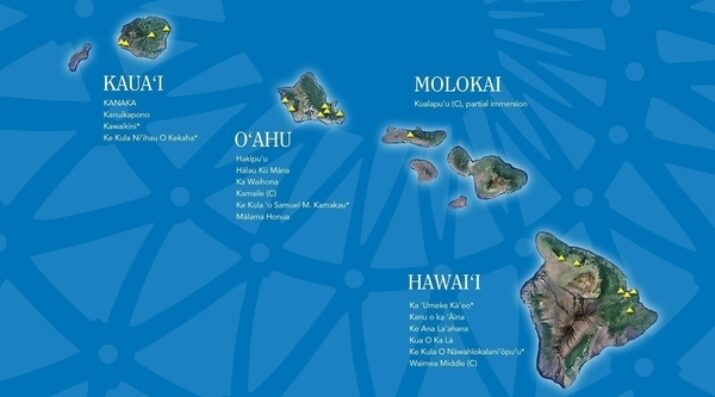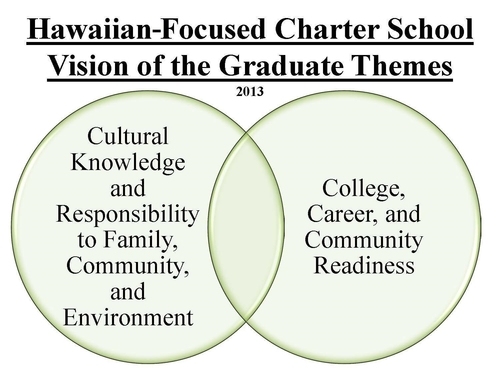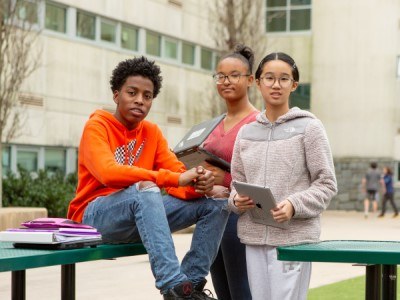Culturally Relevant Performance Assessments: Lessons From Hawaiian-Focused Charter Schools
Topics

Educators are rethinking the purposes, forms, and nature of assessment. Beyond testing mastery of traditional content knowledge—an essential task, but not nearly sufficient—educators are designing assessment for learning as an integral part of the learning process.
Students at Hawaiian-focused Charter Schools complete culturally relevant capstone projects at key junctures in their education journey to demonstrate their learning and growth.
"My parents wanted to give me the values of education that they were unable to have when they were in school. They wanted us to be proud of who we are because we deserve to be the types of people that our kūpuna (ancestors) were. It is not our fault that our practices were interrupted but it is our kuleana (responsibilities and privilege, accountability and authority, roles and rights) to make sure that it does not happen again."
—Grade 12 student at Kanu O Ka ʻĀina
Hawaiian-focused Charter Schools (HFCS) were created in the early 2000s to offer families in Hawaiʻi learning environments that emphasize Hawaiian language, culture, and values. Reflective of the national conversation around equity and the need to support each student to meet his or her full potential, HFCS promote culture-based education by grounding instruction and learning in shared ways of being, knowing, and doing to respond to the needs of indigenous youths. Students apply research-informed literacy, mathematics, science, and social studies content and skills through curricula that focus on reclaiming Hawaiian rights and practices directly tied to traditional and ancestral knowledge. Sadly, much of that knowledge and learning process has been marginalized over years of colonization. HFCS curricula focus on reclaiming Hawaiian rights and practices directly tied to traditional and ancestral knowledge. Place- and land-based education, self-determination, genealogical connections, and noninstrument wayfinding navigation are critical components of HFCS. Currently in 2019, the Hawaiʻi public school system includes a total of 17 HFCS. Collectively, HFCS serve over 4,000 students, 81 percent of whom are part Native Hawaiian.

Figure 1. HFCS Map
Hawaiian-Focused Charter School Vision of the Graduate
While each HFCS is unique in its identity and student outcomes, they collectively exist to perpetuate Hawaiian culture and practices in the 21st century. In 2013, all HFCS leaders crafted the HFCS Vision of the Graduate which articulates these common goals.

Figure 2: HFCS Vision of the Graduate Themes
HFCS Process Rubric
In alignment with Nā Hopena Aʻo, a statewide framework for culturally relevant instruction, the HFCS Process Rubric collectively reports schoolwide processes for cultural, community, college, and career readiness. The process rubric was developed collectively by the HFCS network to consider implementation of culturally relevant instruction across school sites. The rubric is used in conjunction with academic-content rubrics developed by each school. The criteria identify key conditions that create a thriving culture-based learning environment. A dimension of the process rubric featured below focuses on hōʻike, or the demonstration of understanding.
|
NĀ HOPENA AʻO STRAND HAWAIʻI: school processes are grounded in HFCS Vision of the Graduate and reflect HFCS Cultural Competencies. |
||||
|
MUʻO emerging |
LIKO developing |
PEPEʻE implementing |
MAHOLA exemplary |
|
|
Hōʻike: Demonstrate Understanding |
process includes isolated student hōʻike in classroom settings (ex. teacher led in classroom) | process includes regular opportunities for student hōʻike in classroom settings (ex. grade level team) | process includes opportunities at key transition years for students to communicate learning through Hōʻike Capstone Projects connected to the school's vision of a graduate and inclusive of families and community members | process includes routine opportunities for all students to communicate learning through schoolwide Hōʻike Capstone Projects inclusive of families and community members (systematic, institutionalized) connected to the school's vision of a graduate. Hōʻike process is embedded in program, includes post hōʻike staff reflection and impacts curriculum |
Figure 3: HFCS Process Rubric excerpt
Hōʻike Capstone-Project Continuum
In alignment with the HFCS Vision of the Graduate, all HFCS students complete capstone projects at key junctures in their education journey to demonstrate their learning and growth. The Hōʻike Capstone Project Continuum articulates common elements of HFCS Hōʻike Capstone Projects assessed during transition grades identified by each school. The continuum serves to guide rather than evaluate student growth over time, dispelling notions of learning as stagnant and finite. The continuum is a reflective tool used to assess school processes as opposed to individual students. Continuum criteria help schools navigate the development and refinement of student-project rubrics that outline rigorous project expectations and assess individual student proficiency.
The following HFCS examples showcase how assessments are developed with a focus on the past, present, and future.
HFCS Capstone-Project Component 1: Assessing Our Past
"I must have been 20 years old and I had just finished work and was waiting for my ride. This kupuna (elder) walked by, and he said, 'Aloha, pehea ʻoe?,' and I didn't understand him. Then he said, "Auē, how come you Hawaiian girl and you no understand?' I knew from that day that I wanted my children to learn ʻōlelo Hawaiʻi (Hawaiian language)."
—Grade 12 parent at Ke Kula ʻo Samuel M. Kamakau
While Hawaiian language had been the Hawaiian Kingdom's language of government, commerce, and education and even recognized as an official language of Hawaiʻi since 1978, nearly a century of "English only" regulations in the Hawaiʻi school system has led to the drastic decline of speakers. Kula ʻo Samuel M. Kamakau (Kamakau), a P-12 Hawaiian medium school, is reclaiming education through a Hawaiian worldview lens with Hawaiian as the language of instruction. For example, the preschool Hōʻike Capstone Project essential question asks students to explore: What is my place in the kaiāulu (community) as a kanaka (Native Hawaiian)? Students contribute to the well-being of their community and apply their understandings about place to design a solution to a real-world problem. One such capstone project includes expectations that engage students in reciting their family genealogy, writing a book in the Hawaiian language about their school environment, and publishing and presenting their book to an authentic audience. Learners as young as 4 years of age embrace their roles as Hawaiian language speakers and writers and offer their community a meaningful contribution of adding their work to the currently limited body of Hawaiian language resources. For additional information, refer to Kamakau video He Kū'auhau Kamakau: A New Legacy of Education.
HFCS Capstone-Project Component 2: Assessing Our Present
"I can use hoʻomau (perseverance) to turn my challenges into strengths. I want to use what I have learned and the feedback to do better the next time. I do not want to be reminded of the things I have done wrong, so I think using hoʻomau will help me get over that and turn my challenges into strengths that someone sees and they will say, 'Oh wow!'"
—Grade 8 student at Ka Waihona
Eighth graders graduating from Ka Waihona o Ka Naʻauao HFCS create Hōʻike Capstone Projects designed around the following essential question: How can I use my growth in Nā Mea Waiwai Hawaiian values to contribute to my community? Students use new understandings from the inquiry process to activate community engagement and change. Project requirements include a portfolio of learning artifacts that reflect Na Mea Waiwai Hawaiian values and a 15-minute oral presentation to an authentic audience and panel comprising administrators, teachers, 7th grade students, and community members. For additional information, refer to the Ka Waihona Grade 8 Hōʻike Capstone Project rubric and the video Ka Waihona: Hale Building.
The 5th graders at Mālama Honua HFCS explore the following essential question throughout their Hōʻike Capstone Project: How do the traditional Native Hawaiian Mind of a Navigator Skills help me to demonstrate Mālama Honua (care for the Earth)? Their native Hawaiian values-based learning environment emphasizes learning with and from the ʻāina (land), with rigorous instruction in core content and application of knowledge. Project requirements include writing a two-page persuasive essay and developing a five-minute oral presentation for an authentic audience composed of administrators, teachers, and community members. Throughout the project, students actively seek, analyze, and interpret teacher and peer feedback to enhance their project. For additional information, refer to the Mālama Honua Hōʻike Capstone Project rubric and the video Mālama Honua: Teaching Tomorrow's Navigators.
HFCS Capstone-Project Component 3: Assessing Our Future
"If SAT was the only way to demonstrate my learning, that would've been a big struggle, and I would've just studied for the test and afterwards forgot. Less learning is shared on tests than Senior Hōʻike, which incorporates interviews, online research, and book research."
—Grade 12 student at Hakipuʻu Learning Center
The culminating assessment for Hakipuʻu Learning Center seniors is a Hōʻike Capstone Project that demonstrates their readiness to progress to a higher level of kuleana (responsibility and authority). Student voice and advocacy are critical, and student-selected topics, such as fresh-fish farming, taro mapping, college financial planning, and shoreline fishing, reflect students' passions and future career interests. Teachers and subject experts guide students through the inquiry process to explore possible solutions facing their community. Hakipuʻu students document the academic and community-service hours invested in their projects. Figure 4 outlines project scaffolding starting with student projects where staff are the primary drivers of the projects and students produce, among other work, a one-page research paper. As students gain more experience, the project driver transitions to being the student, and requirements increase from a one-page to a 10-page paper. For additional information, refer to the Hakipuʻu Learning Center Hōʻike Capstone Project rubrics and the video Hakipu'u Learning Center: Providing a Plan For Life.

Figure 4: Hakipuʻu Learning Center Hōʻike Capstone Project Guidelines
Conclusion
The HFCS Culturally Relevant Assessments are grounded in HFCS values and provide a counter narrative to the current assessment dialogue. It is vital that evidence of successful learning and innovation are determined by schools and communities rather than by measures that marginalize cultural knowledge, communicate decontextualized outcomes, and are void of the wisdom and values of our ancestors.
Though the approach of HFCS is designed to specifically serve the Native Hawaiian context, this system provides a model upon which other schools and districts might build culturally relevant performance assessments within their own local contexts. At the core of performance assessments is an understanding that students matter as whole beings in the classroom: Their personal histories directly inform their identities as students and reflect their personal educational trajectory that is foundational to becoming college, career, and community-ready graduates. Accordingly, such assessments provide a powerful vehicle for understanding students' cultural identities, not as tangential to their learning, but as essential to their education and critical to their becoming valued contributors who are poised to serve their schools and communities. Historical trauma is reclaimed as a platform to empower individuals as social and political change agents, transforming and restoring the health and well-being to communities.
Learn More
Culturally Responsive Assessment Practices through Nā Hopena Aʻo (HĀ) - The Hawai'i DOE Office of Hawaiian Education is piloting a proficiency-based assessment model that is culturally responsive and place-based.




